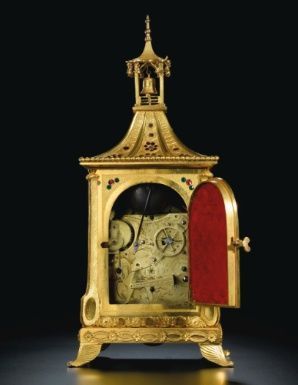An Ormolu And Paste-Set Striking And Musical Clock Qing Dynasty, Qianlong Period - Sotheby's
An Ormolu And Paste-Set Striking And Musical Clock. Qing Dynasty, Qianlong Period - Photo Sotheby's
the richly gilt upright case of rectangular section resting on a square base with four splayed acanthus corner feet joined by stretchers adorned with entwined ribbons and florets, supported at each corner by columns picked out with striations and culmintating in furled acanthus leaves, further inset with alternating ruby-coloured and white brilliants along the edges, the central panel enclosing a painted 3 1/4-inch dial with both Roman and Arabic numerals and reticulated engraved gilt hands, the green and white paste-set bezel with convex glass further surrounded by an applied ruby and green-coloured beads frame, the sides pierced in openwork with an upright oval medallion of petalled flowers further decorated with red and green paste-set at each corner, the back arched door with lattice openwork, opening to reveal the principal three-day duration, five pillars, triple-chain fusees movement with verge escapement and hour striking on a bell, half-hour-passing strikes and two-tone music on eight bells, the back plates engraved with foliate stems and cornucopia, all below a pagoda roof finely incised with tassels and inset with paste-set florets, culminating with a bell tower enclosing a ten-bell carillon, two accompanying keys; 33 cm., 13 in. Estimation: 3,500,000 - 4,000,000 HKD - Lot. Vendu 3,380,000 HKD
NOTE DE CATALOGUE: The Qianlong emperor was an avid collector of timepieces and automatons and his enthusiasm for both European and Chinese-made clocks saw him assemble thousands of varying mesmerising and exquisitely novel designs. The great variety of media employed for the manufacturing of clocks is well illustrated in the Palace Museum, Beijing publication, The 200 Objects You Should Know. Timepieces, Beijing, 2007, including one of related architectural form and splayed feet, pl. 89. A closely related clock also in the Palace Museum, Beijing, is included in Lu Yangzhen, ed., Timepieces Collected by the Qing Emperors in the Palace Museum, Hong Kong, 1995, p. 170. Compare a richly embellished example of related form, from the Nezu Museum, Tokyo, sold at Christie’s Hong Kong, 27th May 2008, lot
1511.
Yang Boda, in the exhibition catalogue Tributes from Guangdong to the Qing Court, Hong Kong, 1987, pp. 55 and 63, notes that a large number of musical clocks were presented to the court by officials in Guangdong in the early and middle Qing period due to the great demand. He writes that ‘the Qing emperors lived and worked under the chimes of their clocks’ with a clock ‘in every hall, on every wall and on every table’. He suggests that while most of those presented for tribute between 1790 and 1794 were probably imported from London, some might have been assembled in Guangzhou, as some of the Guangzhou copies were so close to the European originals.
Sotheby's. Fine Chinese Ceramics & Works of Art. Hong Kong | 09 oct. 2012 www.sothebys.com

/https%3A%2F%2Fprofilepics.canalblog.com%2Fprofilepics%2F1%2F0%2F100183.jpg)
/https%3A%2F%2Fstorage.canalblog.com%2F03%2F02%2F119589%2F96711876_o.jpg)
/https%3A%2F%2Fstorage.canalblog.com%2F11%2F31%2F119589%2F94773502_o.jpg)
/https%3A%2F%2Fstorage.canalblog.com%2F20%2F83%2F119589%2F94772815_o.jpg)
/https%3A%2F%2Fstorage.canalblog.com%2F26%2F72%2F119589%2F75604929_o.jpg)
/https%3A%2F%2Fstorage.canalblog.com%2F59%2F60%2F119589%2F26458628_o.jpg)




/http%3A%2F%2Fstorage.canalblog.com%2F98%2F98%2F119589%2F129097971_o.jpg)
/http%3A%2F%2Fstorage.canalblog.com%2F93%2F75%2F119589%2F128489120_o.jpg)
/http%3A%2F%2Fstorage.canalblog.com%2F09%2F29%2F119589%2F128488304_o.jpg)
/http%3A%2F%2Fstorage.canalblog.com%2F62%2F18%2F119589%2F128488091_o.jpg)